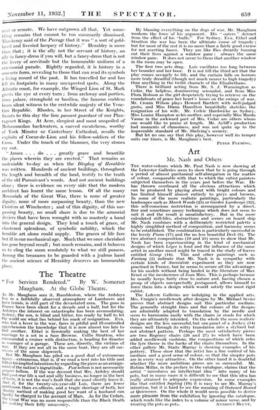Art
Mr. Nash and Others
TILE water-colours which Mr. Paul Nash is now showing at the Leicester Galleries seem to show that he is going through a period of almost puritanical self-abnegation in the matter of colour, comparable with that to which the cubist painters subjected themselves in the years just before the War. He has thrown overboard all the obvious attractions which can be produced by playing about with bright colours and has limited himself almost entirely to greys and browns. In some of the more realistic paintings, particularly the landscapes such as March Woods (25) or Garden Landscape (82), this self-conscious restriction is accompanied by a direct, free and sometimes messy technique which does not seem to suit it and the result is unsatisfactory. , But in the more calculated still-lifes, abstractions and scenes on board ship Mr. Nash combines with a deliberately restricted palette a highly simplified method of composition, and harmony seems to be established. The combination is particularly successful in the lovely Piano (17) and the no less beautiful Deck (9). The two abstract compositions (19 and 21) seem to show that Mr. Nash has been experimenting in the kind of mechanical designs of which Leger is fond and the influence of the same artist in another mood might be traced in the study of leaves entitled Group (18). This and other paintings such as Fantasy (2) indicate that Mr. Nash is in sympathy with certain kinds of Surrialiste experiment as they are now practised in France, but he seems to secure all the advantages for his models without being landed in the literature of Max Ernst or the incoherence of Joan Miro. This is perhaps because he usually keeps fairly close to nature and, having chosen a group of objects unexpectedly juxtaposed, allows himself to force them into a design which would satisfy the most rigid cubist.
The Lefevre Galleries are indulging in the applied arts. Mrs. Craigie's needlework after designs by Mr. Michael Sevier proves that abstract designs suit this particular medium. The generally straight lines and flat colours of the designs are admirably adapted to translation by the needle and seem to harmonize easily with the chairs or stools for which they are ultimately intended. On the whole the more realistic designs are the less successful, but one panel of a Jockey (14) comes well through its witty translation into a stylized but not abstract pattern. Perhaps the most satisfactory pieces are two Regency chairs (26 and 27) to which have been added needlework cushions, the compositions of which echo the lyre theme in the backs of the chairs themselves. In the other gallery Mr. Staite Murray is showing examples of his pottery. These show that the artist has a fine control of his medium and a good sense of colour, so that the simpler pots are in every way attractive. On the other hand it is doubtful whether the more ambitious pieces are so successful. Mr. Robins Millar, in the preface to the catalogue, claims that the artist " introduces, an intellectual idea " into many of his pots, but in many cases it is difficult to see that this idea has really attained to adequate expression. In some examples like that entitled Sapling (10) it is easy to see Mr. Murray's intention, but it is hard to see the meaning of Outward Bound or Quiescence. On the whole it would seem possible to derive more pleasure from the exhibition by ignoring the catalogue, which reads like the index to a, volume of minor verse, and by






























 Previous page
Previous page